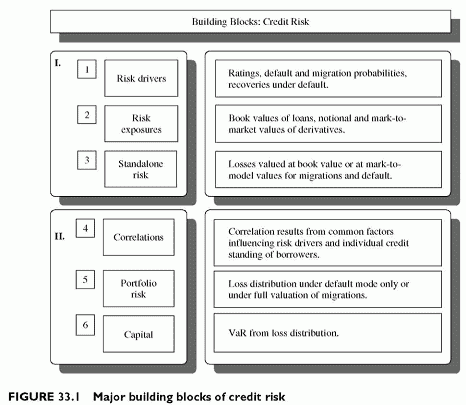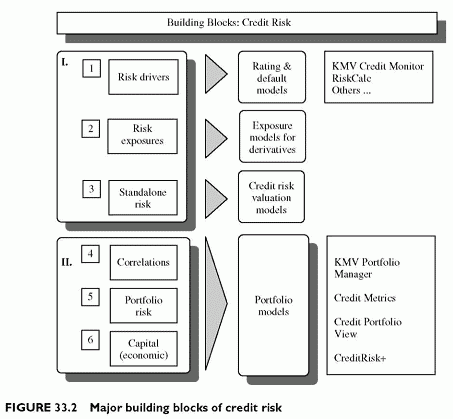Overview of Credit Risk Models
Category: Risk Management in Banking
This chapter provides an overview and a summary of credit risk models, as described in subsequent chapters, and plays a key role in the presentation of credit risk modelling. There is a wide spectrum of credit risk models, addressing different issues with different techniques, making an overview necessary.
Some models serve for defining the credit risk drivers of individual transactions: exposures, recoveries and default plus migration probabilities. Other models use these as inputs for modelling the credit risk of portfolios of loans or bonds. We designate this second category as portfolio models. The chapter describes the major building blocks of credit risk modelling. It details the techniques used for modelling credit risk drivers then the specifics of each of the four major portfolio models (vendors models). These are Credit Metrics, KMV Portfolio Manager, Credit Portfolio View (CPV) and CreditRisk+.
There are two alternative approaches for presenting portfolio models. The first presents sequentially each of the existing vendors models. The second details how each existing portfolio model deals with each basic modelling building block, moving from one building block to the next, rather than from one model to the next. This chapter uses the second approach, the building block, rather than the more common sequential description of each vendors model. The rationale for this view by building block, rather than by model, is twofold. First, it makes more explicit the alternative methodologies serving similar purposes within each model building block. Second, it facilitates the comparison of techniques across models. The drawback is that this approach is not a substitute for full descriptions of each model. Therefore we provide in this chapter summarized reviews of each of the major models. This allows readers to start with the overview before moving on to details and to easily shift later back and forth from the model view to the building block view.
The first section provides a map of credit risk model building blocks. It is an outline of subsequent chapters. The subsequent sections summarize issues and techniques for each modelling block. Each section is a summary of the subsequent chapters. The last section cross-tabulates vendors models with the basic techniques that different credit risk models bundle in different ways.
THE BUILDING BLOCKS OF CREDIT RISK MODELS
The general structure by building blocks applies for credit risk as it does for market risk. However, in the case of credit risk there are several vendors models using different techniques. The first building blocks relate to the inputs to portfolio models, such as default probabilities. Credit Monitor from KMV and RiskCalc from Moodys (Moodys Investors Service, 2000b) model default probabilities and there are numerous models using statistical techniques aimed at the same purpose. The second building block deals with portfolio risk. Portfolio models include KMV Portfolio Manager, Credit Metrics (J. P. Morgan, 1997), CPV (Wilson, 1997a, b) and CreditRisk+ (Credit Suisse, 1997).
Portfolio models use exposures, ratings or default probabilities, and recoveries as inputs. Figure 33.1 summarizes the general structure for credit risk, ignoring blocks III (top-down links) and IV (risk-return), which are transversal to all risks. Focusing on the main blocks only, Figure 33.2 shows how the vendors models map to this general structure.
We focus on the first two main blocks: standalone risk of individual transactions and portfolio risk. Since credit risk portfolio models extend to capital allocation and individual risk-adjusted measures of performance, we add a brief description of building blocks II and IV. The capital allocation and the risk-return building blocks are technically identical for market and credit risk, except that market risk models do not integrate them.


